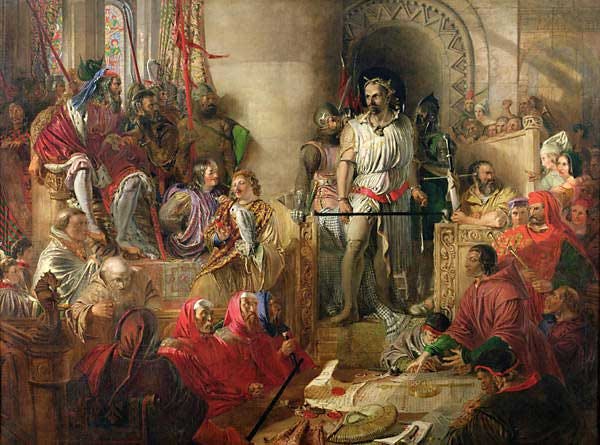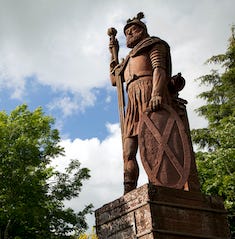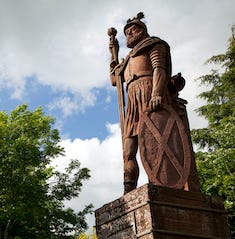The Trial and Death of William Wallace
And 'Cutting Room' Scene from the Novel Despenser
Thanks to the film ‘Braveheart’, William Wallace has pretty much become a household name. But, of course, the film contains more fiction than fact when it comes to historical details. In fact, it has been described as ‘probably the most historically inaccurate movie ever made.’ 1 One of the rare accuracies of the film, though, was Wallace’s execution in August 1305. As this was the year before Hugh Despenser the younger married Eleanor de Clare, he may have witnessed Wallace’s trial in Westminster and death in Smithfield.2
Wallace was captured on 5th August 1305 in a remote cottage by Sir John Menteith, the keeper of Dumbarton Castle, and his men. Menteith was a Scottish knight loyal to Edward I, but even he probably would have been unable to locate Wallace without some sort of information or treachery. The English chronicler Piers Langtoft, who died circa, 1307, wrote that it was Jack Short, Wallace’s servant, who betrayed his master although, of course, this is impossible to prove.3 Wallace was taken to London under an escort commanded by Sir John Segrave. Several contemporary sources say that Wallace came face-to-face with Edward at some point, but that Edward turned away from him in disdain. Whatever the truth in the matter, Wallace and Segrave reached London on 22nd August. News of Wallace’s arrival preceded them and the streets were thronged so tightly with curious and hostile crowds that it was deemed to be safer to lodge the Scotsman in a well-defended house in Fenchurch Street for the night instead of trying to reach the Tower.4
The next morning, Wallace was taken to Westminster Hall for what was a pretence of a trial. On arrival, he was sat on a bench on the south side and crowned with a wreath of laurel leaves to mock his boast that he would one day sit on the throne of England. The men appointed by Edward to judge Wallace were Sir John Segrave, Sir Peter Mallory (Justiciar of England), Ralph de Sandwich, John de Bacwell (famously crushed to death at Edward II’s coronation), and Sir John le Blound (Mayer and chief Magistrate of London).5 The judges were there just for show – Edward had already decided the outcome. Nevertheless, the pretence of a trial continued.
The charges were recorded in a medieval manuscript that was destroyed by fire in 1731. Luckily for us, a transcription, completed before then, still exists. The charges read:
He [Edward I] had appointed and set up the Guardians of that land, appointing the sheriffs, the provosts, the bailies and other ministers of his, in his place, to maintain his peace and give justice to all whomsoever according to the laws and customs of that land.
The aforesaid William Wallace, forgetful of his fealty and allegiance, raised up all he could by felony and premeditated sedition against the same lord the King, having united and joined to himself an immense number of felons, and he feloniously invaded, and attacked the Guardians and ministers of the same King, feloniously and against the same lord the King’s peace, insulted, wounded and killed William de Heselrigg, sheriff of Lanark, who the appointments of the said King in the regular meeting of the county court, and afterwards in contempt of the same king without reason fought against the same sheriff whom he had killed.
Thenceforth with the entire multitude of those who adhered in arms to him and to his felony, he invaded the towns, the cities and the castles of that land, and had his letters [orders] sent throughout the whole of Scotland, as if they were the letters of the superior of that land. He held and appointed parliaments and conventions after all the Guardians and ministers of the aforesaid lord the King of the land of Scotland had been evicted by William himself, and unwilling to restrain himself to so much wickedness and sedition, decreed to all the prelates, earls and barons of his land who adhered to his party, that they were to subject themselves to the fealty and dominion of the king of France, and they were to press for help towards the destruction of the kingdom of England. Taking some also from his accomplices with him he invaded the kingdom of England, as in the counties of Northumberland, Cumberland and Westmorland, and all whom he found there who were in the fealty of the King of England, he feloniously put to death in various ways.
He feloniously and seditiously slaughtered religious men and monks dedicated to God, and burnt and laid waste churches constructed for the honour of God and the saints, together with the bodies of the saints and other relics of them that had been honourably collected therein; he spared no-one who spoke the English language, but afflicted all, old men and youths, wives and widows, children and babes in arms with a more grievous death than could be considered. And so, every day and every hour, he seditiously and feloniously persisted in contriving the death of the same lord the King, and the destruction and the manifest weakening of the crown and his royal majesty. And it is clear that after such outrageous and horrible deeds, the aforesaid lord the King, together with his great army, had invaded the land of Scotland and had defeated the aforesaid William, who was bearing his standard against him in mortal warfare, and other enemies of his, and had granted his true peace to all from that land and had mercifully taken the aforesaid William Wallace back into his peace, the said William seditiously and feloniously, whole-heartedly and undauntedly persevering in his above noted wickedness, disdained to submit himself to the aforesaid lord King’s peace and to come forth to it, and so was publicly outlawed in the court of the same lord the King as traitor, robber and felon, according to the laws and customs of England and Scotland.
Wallace was not given the chance to defend himself, but allegedly, during the trial, Wallace conceded all the crimes mentioned in the charge except for that of treachery to the English king, as he had never sworn allegiance to him in the first place. Once the charges had been read, he was immediately declared guilty and John de Segrave then read out what his punishment would be: to be drawn, hung, disembowelled, and quartered – the fate of traitors.

As soon as the sentence had been pronounced, Wallace was stripped naked and tied to a hurdle that was fastened to the tails of two horses. He was thus dragged from Westminster along rough and filthy streets to the Elms in what was later known as Smithfield. Along the way he would have been subjected to jeering crowds throwing whatever they could get their hands on – stones, offal, excrement. Once at the destination of his execution, he would have been manhandled to the gallows, and allowed a last confession (there is no evidence of Edward I refusing it, as is related in some stories). Once shriven, his hands would have been bound behind him and he would have been made to climb a ladder to the scaffold. There he was hung until nearly dead. As there was no ‘long drop’ method of hanging in those days (and would not be until the 19th century), he suffered slow strangulation until barely conscious. He would then have been brought down, strapped to some sort of frame or table and his genitals cut off and thrown into a fire. Following that, his abdomen would be cut open and his intestines, liver, lungs, and heart pulled out and also cast into the flames. By now, mercifully, his suffering would have ended, but the violence upon his body did not. His head would have been cut off and his remains quartered.
After this hideous death, there was no Christian burial – considered essential if a person was to be reconciled to God at the Resurrection. Instead, his head was dipped in tar to preserve it and displayed on a spike on London Bridge. The four quarters, as per the sentence were taken to the following towns: his right arm at Newcastle-upon-Tyne, his left arm at Stirling, his left leg at Perth, and his right leg at Berwick. However, these towns vary in the various chronicles that document the execution.6
If Hugh Despenser the younger had been present at Wallace’s death, it may have been the first execution of this kind that he attended. However, it wasn’t to be the last – that would be his own grisly execution 21 years later.
Katie Mach, ‘Braveheart May be the Most Historically Inaccurate Movie Ever Made,’ Ranker, 30/01/2020, accessed at https://www.ranker.com/list/historical-mistakes-errors-and-inaccuracies-in-braveheart/machk on 16/04/2021
Edward I was hunting in Essex at this time, so it is also possible that he was there with Edward’s court instead.
‘Menteith and William Wallace,’ Wallace Society, accessed at http://www.thesocietyofwilliamwallace.com/menteithtraitor.htm on 16/04/2021
James Mackay, William Wallace: Brave Heart, Mainstream Publishing, 1995.
Ibid.
Ibid.
Scene from Despenser Novel (Discarded) about Wallace’s Trial: 1st draft
The two men hugged before Hugh’s father turned to him.
‘This is Sir John Segrave, son.’
Segrave turned to Hugh, his smiling grey eyes assessing him. ‘So, this is the son and heir, eh? I’m guessing he gets his good looks from his mother’s side then.’
Hugh’s father laughed. ‘And probably a good thing too! Will you be staying here long?’
Segrave shook his head. ‘No. As soon as the sentence has been carried out, I have the unenviable task of making sure Monsieur Wallace’s parts are taken up to various places in the north. Hopefully, it may put off others who are thinking of causing trouble.’ He smoothed a hand through his soldier’s short-cropped hair, his smile suddenly disappearing, and Hugh realised that behind the jovial front was a man who held huge responsibilities for both lands and men's lives.
Any other conversation was interrupted by the loud clanging of a handbell calling all to order. Everyone took to their places; Segrave said his farewells to Despenser father and son and then took up his place sitting at the centre of the King’s Bench, with two of the king’s judges on either side. One of the sheriffs ran the bell again and called first for silence, and then for the prisoner to be brought in. Behind him, Hugh heard shuffling and murmurs as people jockeyed for a better viewing position.
For some reason, he had expected Wallace to be dragged in, struggling. But, instead, he watched as a tall, well-built man calmly walked through the door, flanked by his guards, but not being held by them. He looked to be in his mid-thirties with unkempt hair and beard, and a livid bruise staining his right cheek and nearly closing his eye. He moved with dignity, head held high, even despite the chains that bound him, although Hugh could see that they were more for humiliation than restraint.
For a moment, he stopped and stared around him, maybe hoping to see the English king. Then his eyes briefly rested on Hugh. Even in that short instant, he could see the hatred burning in them. Hatred and contempt for everyone in the hall.
Wallace was brought in front of the bench and, when he refused to kneel, was forced onto his knees by the men-at-arms. Segrave then stood and read out the crimes that Wallace was to be charged with - treason against his overlord, King Edward I, and atrocities against English civilians, sparing neither age nor sex, monk nor nun.
As soon as it was read out, Wallace struggled to rise to his feet. ‘I cannot be a traitor, for I owe Edward no allegiance. He is not my Sovereign; he never received my homage; and whilst life is in this persecuted body, he never shall receive it. To the other points whereof I am accused, I freely confess them all. As Governor of my country, I have been an enemy to its enemies; I have slain the English; I have mortally opposed the English King; I have stormed and taken the towns and castles which he unjustly claimed as his own. If I or my soldiers have plundered or done injury to the houses or ministers of religion, I repent me of my sin; but it is not of Edward of England I shall ask pardon.’
‘Silence!’ roared Segrave and gestured to the guards to control their prisoner. At once they forced him back onto his knees, stuffing a filthy rag into his mouth.
Hugh had expected to hear arguments for and against Wallace’s guilt, but there were none. As soon as the charges had been read out, the judges talked among themselves for the briefest of moments before announcing that he was guilty of all crimes. Segrave rose once again and stared at Wallace with the smallest hint of a smile playing around his mouth.
‘William Wallace, you have been hereby judged guilty of the crimes of treason and murder of innocent men, women, and children. You will be drawn to your place of execution, hung until nearly dead, disemboweled, and beheaded. Your body will then be divided into quarters which will be taken to Newcastle, Berwick, Stirling, and Perth. May God have mercy on your soul. Take him away.’
Wallace visibly paled, although surely he could have expected no other fate. He tried to stand but this time his legs seemed to collapse beneath him and he was dragged out by the men at arms. Even so, he did not shout or struggle, and even though he could hardly walk, he still managed to keep a thin veneer of dignity.
As Wallace was led out of the large oak door into the courtyard, the trial’s spectators jostled to follow. They watched as the Scot was forced onto a roughly made hurdle and tied to it by his ankles and wrists. Two nervous bays were being led forward for the dubious honour of pulling the condemned man to his fate. Hugh expected his father to use his authority to push through the jubilant throng, instead he grabbed his arm and pulled in the other direction.
‘I have two horses saddled,’ he said, ‘and if we go now we’ll reach the Elms at Smithfield before they do - and then you will see how a traitor dies.’






